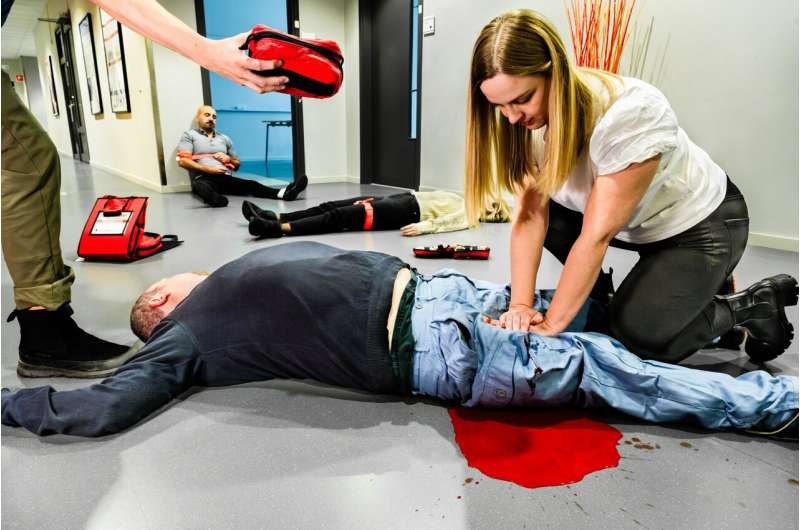This article has been reviewed according to Science X's editorial process and policies. Editors have highlighted the following attributes while ensuring the content's credibility:
fact-checked
peer-reviewed publication
trusted source
proofread
Computer simulations reveal best placement areas for bleeding control kits in public spaces

Where should bleeding control equipment be located to save as many lives as possible? Researchers at Linköping University in Sweden, in collaboration with U.S. researchers, have found the answer to this through computer simulations of a bomb exploding in a shopping center. One of the most important conclusions: Bleeding control kits should not be located at entrances.
In the event of an accident or an attack, members of the public can save lives by performing first aid measures until the arrival of emergency medical services. But it is not enough that people see themselves as life-saving immediate responders, prepared and able to act.
"There must also be certain equipment available to manage major bleeding. The question then is where this equipment should be placed, so that people who want to help can quickly access bleeding control kits," says Carl-Oscar Jonson, adjunct senior associate professor at the Department of Biomedical and Clinical Sciences at Linköping University and head of research at the Center for Disaster Medicine and Traumatology in Linköping.
Until now, there have been no guidelines for where such bleeding control kits should be located to ensure maximal utility. The current study, published in the journal Disaster Medicine and Public Health Preparedness, now contributes research-based recommendations.
"We found that the largest number of lives saved correlated with bleeding control kits being placed in two or more locations on the premises, but most importantly they shouldn't be placed at entrances. We also concluded that the equipment must be accessible within 90 seconds' walking distance," says Anna-Maria Grönbäck, doctoral student at the Department of Science and Technology at Linköping University, who was involved in developing the simulation.
This means that bleeding control kits should not be placed at entrances, which is often the case with automated external defibrillators (AEDs). The reason for this is that they may be difficult to reach in a situation where many people have to be evacuated at once, such as in the case of attack or major accident. According to attack statistics, roughly 20 injured people will need first aid including a bleeding control kit each. It may be helpful to locate bleeding control kits in the same places as clearly marked AEDs, as long as not located at the entrances.
The recommendations are based on conclusions reached by the research team by developing a computer-based simulation of an explosion in a large shopping center with thousands of simultaneous visitors. In their simulation, the researchers have looked at what happens right after an explosion.
The majority of the simulated people try to get out of the premises and move toward the exits. Simulated people close to the blast suffer varying degrees of injury and start bleeding. In the simulation, some individuals help those injured by applying direct pressure to reduce bleeding, or by trying to find equipment. It is a race against time. Depending on how long it takes to get the equipment, the simulated injured people may die from blood loss.
To find the best strategy for the placement of bleeding control kits, the researchers tested four different scenarios in their simulation. They weighed together the outcomes of the many simulated courses of events for each scenario and compared them to understand which placement of equipment saved the largest number of lives.
The current study is a collaboration project between the Center for Disaster Medicine and Traumatology in Linköping, the Department of Computer and Information Science and the Department of Science and Technology at Linköping University and American experts affiliated with the National Center for Disaster Medicine and Public Health. While the placement of bleeding control kits in sports arenas and similar has become increasingly common in the U.S., it is so far a rarity in Sweden.
"I hope policymakers and public venues can use this study to guide plans and decisions about where to locate public-access bleeding control supplies. For example, our study suggests that supplies co-located with AEDs would be more beneficial than those located near exits. In an emergency when minutes matter, having equipment readily accessible might mean the difference between life and death," says Craig Goolsby, Professor of Clinical Emergency Medicine at the David Geffen School of Medicine at UCLA and Chair of the Department of Emergency Medicine at Harbor-UCLA Medical Center, U.S.
More information: Krisjanis Steins et al, Recommendations for Placement of Bleeding Control Kits in Public Spaces—A Simulation Study, Disaster Medicine and Public Health Preparedness (2023). DOI: 10.1017/dmp.2023.190



















